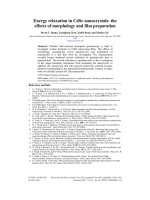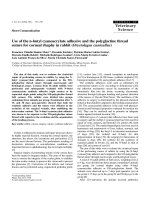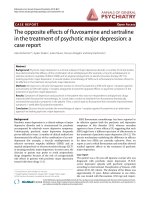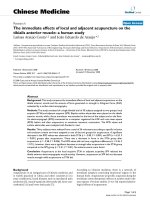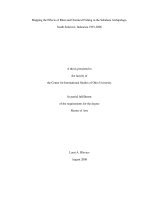The n effects more compertiters and less compertition
Bạn đang xem bản rút gọn của tài liệu. Xem và tải ngay bản đầy đủ của tài liệu tại đây (213.67 KB, 23 trang )
Running head: THE N-EFFECT
The N-Effect: More Competitors, Less Competition
Stephen M. Garcia
Avishalom Tor
University of Michigan
University of Haifa
Citation for paper:
Garcia, S.M., & Tor, A. (2009). The N-Effect: More competitors, less competition.
Psychological Science, 20, 871-877.
Keywords: SOCIAL COMPARISON, COMPETITION, MOTIVATION
Electronic
Electroniccopy
copyavailable
availableat:
at: /> />
N-EFFECT 2
Abstract
The present analysis introduces the N-Effect – the discovery that increasing the number of
competitors (N) can decrease competitive motivation. Studies 1a-b found evidence that
average test scores (e.g., SAT scores) fall as the average number of test-takers at testtaking venues increases. Study 2 found that individuals trying to finish an easy quiz
among the top 20 percent in terms of speed finished significantly faster if they believed
they were competing in a pool of 10 versus 100 other people. Using a social comparison
orientation (SCO) scale, Study 3 showed the N-Effect occurs strongly among those high
in SCO and weakly among those low in SCO. Study 4 directly linked the N-Effect to
social comparison, ruling out the “ratio-bias” and finding that social comparison becomes
less important as N increases. Finally, Study 5 found the N-Effect is mediated by social
comparison. Limitations, future directions, and implications are discussed.
Electronic
Electroniccopy
copyavailable
availableat:
at: /> />
N-EFFECT 3
The N-Effect: More Competitors, Less Competition
Modern life often seems like a rat-race. But does one's motivation to run the maze, to
compete, depend on how many other “rats” are in the race? When there is only one gold medal,
for instance, increasing the number of contestants from 10 to 100 reduces each contestant's
probability of winning and may therefore lead them to reduce their competitive efforts. We
propose, however, that mere knowledge of the number of competitors can independently impact
competitive motivation even where the chances of success remain constant. The present analysis
thus introduces the N-Effect – the discovery that increasing the number of competitors ("N")
decreases the motivation to compete.
While our primary objective is to introduce a new phenomenon and link it to the social
comparison process, the N-Effect finding simultaneously makes two important theoretical
contributions: First, it advances a new direction in social comparison research, which has
traditionally examined how subjective factors amplify competition (Festinger, 1954; Tesser,
1988), but recently began exploring how objective, contextual, factors also impact the motivation
to compete (e.g., Garcia, Tor, Bazerman, & Miller, 2005; Garcia, Tor, & Gonzalez, 2006; Garcia
& Tor, 2007). The N-Effect continues in this direction, revealing the impact of a ubiquitous
contextual factor – the number of competitors – on social comparison and, thus, on competitive
motivation. Second, the present analysis reveals a boundary condition of social facilitation.
While competitive motivation increases in the presence of a few others (Zajonc, 1965), we show
it diminishes when the few become many competitors.
Electronic copy available at: />
N-EFFECT 4
Social Comparison and the Competitive Landscape
Social comparison processes fuel the motivation to compete (Festinger, 1954; Garcia, et
al., 2006; Johnson & Stapel, 2007). People ("Actors") comparing themselves to others
("Targets") on an important dimension begin to behave competitively toward them (e.g., Garcia
& Tor, 2007; Hoffman, Festinger, & Lawrence, 1954; Poppe & Valkenberg, 2003).
Traditionally, researchers emphasized three factors that impact social comparison-based
competitive behavior: (i) importance of the performance dimension (Festinger, 1954; Tesser,
1988), (ii) commensurability of the Target (Goethal & Darley, 1977), and (iii) Target-Actor
relationship closeness (Tesser, 1988). These factors are all subjective, varying among similarly
situated Actors.
Recent studies, however, illuminate the important role of objective, contextual, features
of the competitive landscape in shaping social comparison processes (Garcia, et al., 2005;
Garcia, et al., 2006; Garcia & Tor, 2007), showing , for example, that competitive behavior only
occurs when rivals are near a standard, an acknowledged measure of comparison. On the other
hand, rivals not in the proximity of a standard exhibit fewer social comparison concerns and
become less competitive (Garcia, et al., 2006; Garcia & Tor, 2007). In the same vein, the present
analysis identifies the impact of N – another ubiquitous contextual factor – on social comparison
and thus competitive motivation.
Among a few competitors, Actors can compare their performance to that of any given
Target, a situation that fuels the motivation to compete (Festinger, 1954). We posit, however,
that when N is large, social comparison concerns – which are, after all, an interpersonal,
information-based process (Festinger, 1954) – become diffused by the sheer number of
competitors. While Actors can experience or anticipate social comparisons between themselves
Electronic copy available at: />
N-EFFECT 5
and a few others, it becomes less viable and informative to compare oneself, or anticipate
comparisons, with a great multitude of Targets. For this reason, we hypothesize that in large N
environments social comparison becomes less important and competitive motivation diminishes.
The Presence of Others and Motivation
The N-Effect contributes to the extant literature on the presence of others and motivation.
For instance, "social loafing" findings (Latané, et al., 1979) reveal that individual effort generally
decreases when an individual task is transformed into a collective group task. Nevertheless,
individual performance feedback can increase motivation in collective tasks (e.g., Williams,
Harkins & Latané, 1981), and heightened social comparison and competence concerns can
reduce loafing as well (Kerr & MacCoun 1984).
The finding that the presence of others can increase motivation when raising social
comparison concerns also appears in the social facilitation literature (Zajonc, 1965). In this case,
motivation and effort increase through coaction effects (Zajonc, Heingartner, & Herman, 1969)
when individual – rather than collective – tasks are performed in the presence of a few others.
We suggest that, like facilitation, the N-Effect is manifested in individual tasks. However,
unlike facilitation, which compares an individual alone versus amongst a few others, this effect
occurs in already competitive settings, when an environment with only a few competitors is
compared or transformed to one with many competitors. We hypothesize that in these situations
– where social facilitation and social comparison already are present – an increase in N would
have the opposite effect of reducing social comparison concerns and thereby decreasing the
motivation to compete and generating the N-Effect.
Electronic copy available at: />
N-EFFECT 6
Studies 1a and 1b: Test-Taking Evidence
We first probed for the N-Effect in two datasets possessing a high degree of external
validity, namely the Scholastic Aptitude Test (SAT) and the Cognitive Reflection Test (CRT).
We examined SAT scores at the publicly available state-level,1 and corroborated this evidence by
examining an individual-level data set on CRT scores2, which are highly correlated with SAT
and intelligence measures (Frederick, 2005). We predicted that denser test-taking environments
– where more test-takers are present in a testing venue – diminish competitive motivation and
consequently reduce both SAT and CRT scores.
Data Sets
Study 1a: SAT State-Level Data
Key Variables. We constructed a dataset based on the publicly available state-level 2005
SAT results published by The College Board for all 50 states. In addition to the combined SAT
score (SCORE), we created a test-taker density variable (DENSITY) for each state by dividing
the total number of test-takers for 2005 in each state by the total number of test-taking venues in
that state. Hence, DENSITY provides a state-level average of test-taker N.
Control Variables. In an attempt to minimize potential confounds, we controlled for
relevant variables at the state level: the percent of high school students who take the SAT, the
10-year trend for performance on the SAT, the percent of test-takers who reported having parents
with a college degree or higher, and the percent of test-takers who were self-identified as ethnic
minority. We also controlled for important demographic variables by state: funding of state and
local governments for elementary and secondary education (U.S. Department of Education,
National Center for Education Statistics, 2005 table on 2002-03 data); per capita income (2004
Table of the Bureau of Economic Analysis); and population density (2000 U.S. Census). Finally,
Electronic copy available at: />
N-EFFECT 7
we controlled for the percentage of high school students who take the ACT (the other main
college entrance exam) and the average ACT score for each state.
Study 1b: Cognitive Reflection Test Data
Key Variables. We obtained a data set of CRT scores based on a sample of 1,383
University of Michigan undergraduates (711 female, 633 male, 39 n/a) collected over a threeyear period that involved a total of 22 test-taking opportunities. Students took the CRT in a testtaking environment that was standardized across all 22 test-taking opportunities and was always
part of a larger questionnaire day.
Results and Discussion
Study 1a: SAT Scores. As predicted, a significant inverse correlation emerged between
DENSITY and SCORE (N=50, r=-.68, p<.05); the denser the test-taking environment, the lower
the SAT score. We also conducted a partial correlation to control for the aforementioned control
variables, and the inverse correlation between SCORE and DENSITY remained significant
(N=50, df=39, r=-.35, p<.05). This result indicates that the more people showing up, on average,
at the test-taking venue, the lower the SAT score.
Study 1b: CRT Scores. In a parallel analysis, we correlated the total number of
participants that showed up for one of the 22 CRT test-taking opportunities with the
corresponding average score of that particular session. As with the SAT analysis, we observed a
strong inverse correlation between NUMBER and CRT scores (N=22, r= -.56, p<.01); this
inverse correlation remained, controlling for gender (N=22, df=19, r=-.48, p<.05). Hence, the
more participants that were present in a particular CRT test-taking session, the lower the CRT
score for that particular session.
Electronic copy available at: />
N-EFFECT 8
The SAT results, although striking, are subject to potential confounds, most notably
distraction and self-selection. Denser test-taking environments may produce increased distraction
that accounts for diminished performance. However, The College Board goes to great lengths to
standardize the testing-taking environment within each venue, with high-volume centers
typically trafficking students into one of many classrooms, making variable distraction during
the test unlikely. Similarly, self-selection might have explained the data if better test-takers were
to self-select to lower-density states, but there is little reason to believe this is the case. We
nevertheless acknowledge the limitations of the SAT real-world data, which was available only
at the state-level.
Importantly, however, the CRT scores were available at the individual level, in a
comparatively homogenous University of Michigan sample, and thus afforded a better-controlled
analysis which still provided clear evidence for the N-Effect. Here, moreover, the test-taking
environment was standardized and self-selection irrelevant. Both SAT and CRT analyses thus
support the N-Effect, which we next examined experimentally under controlled random
assignment.
Study 2: Diminished Experimental Performance
Study 2 tested the N-Effect in a task where participants were given an easy but timed
quiz, having been told their goal was to finish as fast as possible without compromising
accuracy. We predicted the participants in the 10-person condition would be more competitive,
completing the quiz significantly faster than those in the 100-person condition.
Electronic copy available at: />
N-EFFECT 9
Participants
Seventy-four University of Michigan undergraduates (33 female, 41 male) were recruited
while studying alone at university libraries. Because the quiz was timed, only native English
speakers were recruited.
Procedure
Experimenters asked potential participants if they would be willing to take part in a short
experiment. One experimenter then handed participants a two-page packet (a cover page
followed by a short quiz page) and explained they would be taking a timed quiz and their goal
was to finish the quiz as fast as possible without compromising accuracy. Participants were told
they were competing against either 10 or 100 other participants and that those scoring in the top
20 percent in completion time would receive $5. The short quiz contained four general
knowledge multiple-choice questions (e.g. "Who is the Secretary General of the UN?") and four
true-false statements (e.g., "Michigan is shaped like a shoe").
Once the first experimenter gave participants the packets and instructions, the second
experimenter, blind to the experimental condition, informed participants he would begin timing
them with a stopwatch. Afterwards, each participant wrote their e-mail address, in case they
scored in the top 20th percentile. Participants in the top 20 percent were later paid $5.
Results and Discussion
There were no significant accuracy or gender by condition interactions (F’s<1).
Importantly, participants in the 10-person condition completed the quiz significantly faster
(M=28.95, SD=7.69) than those in the 100-person condition (M=33.15, SD=10.06; F(1,73) =
4.09, p< .05). Study 2 thus provides a between-subjects, direct, behavioral measure of the NEffect, showing increased N to diminish competitive motivation on an individual task.
Electronic copy available at: />
N-EFFECT 10
Moreover, because the effect was generated by mere knowledge of N it cannot be explained by
mechanisms that require the actual presence of N (e.g., “arousal” or “coaction effects”). Notably,
however, mere information is known to suffice for social comparison processes (Suls &
Wheeler, 2000). Tentatively supporting a social comparison account of the N-Effect, moreover,
a post-test suggested that social comparison concerns play a significantly greater role in the 10person condition than in the 100-person condition.3
Study 3: Social Comparison Orientation and the N-Effect
Study 3 further probed social comparison’s role in the N-Effect, using a social
comparison orientation (SCO) scale (Gibbons & Buunk, 1999) to reveal interpersonal differences
in the effect. The prediction was that high SCO individuals will be more likely to exhibit the NEffect than low SCO ones.
Participants
Forty-seven undergraduate students (24 female, 23 male) from a Midwestern university
participated in an online study. A total of 250 randomly selected e-mail addresses from the
undergraduate student directory were e-mailed but a few e-mails “bounced-back.” The response
rate was approximately 20 percent.
Procedure
In a within-subjects design, participants read two randomly presented vignettes:
“Suppose you are running in 5-K with 50 [500] people of similar running ability as yours. You
have been told at the start of the race that all those who finish in the top 10% will get a $1,000
prize.” Participants responded to the dependent variable, “To what extent would you run faster
than normal?” (1=Faster than normal, 7=Fastest in my life). Participants also responded to the
11-items of social comparison scale (Gibbons & Buunk, 1999).
Electronic copy available at: />
N-EFFECT 11
Results and Discussion
Participants indicated trying significantly harder in a 5-k race with 50 contestants
(M=5.43, SD=1.63) than with 500 contestants (M=4.89, SD=1.71): The “NUMBER” withinsubjects factor was significant (F(1,46)=11.4, p<.01). Moreover, when inputting the continuous
SCO measure in the within-subjects ANOVA as a covariate, we observed a significant
interaction between “NUMBER” and SCO (F(1,45)=5.41, p<.05). As predicted, individuals
with increasingly higher SCO were more likely, while those increasingly lower in SCO were less
likely, to exhibit the N-Effect. We also conducted a median split on SCO,4 finding that among
High SCO participants the N-Effect was pronounced (Few Competitors: M=5.87, SD=1.36;
Many Competitors: M=5.22, SD=1.51; t(22)=2.91, p=.008), while among Low SCO participants
it was insignificant (Few Competitors: M=4.95, SD=1.85; Many Competitors: M=4.70,
SD=1.95; t(19)=1.00, p=.33). Study 3 thus shows social comparison is a necessary precondition
for the N-Effect.
Study 4: Social Comparison or Ratio-Bias?
Study 4 began examining social comparison against alternative accounts, focusing on the
potential role of the “ratio bias” (Denes-Raj & Epstein, 1994) alternative in generating the NEffect. The ratio bias leads individuals to think it is easier, for instance, to draw one red jellybean
from a jar containing 10 red out of 100 beans than to draw the only red bean out of a jar
containing 10 beans, despite the equal probabilities of the two tasks. Competitors exhibiting this
bias may reduce their efforts when facing a large N simply because they think their chances of
success are higher than in small N settings, despite being told otherwise. Although the ratio-bias
is primarily a within-subjects effect (e.g., Denes-Raj, et al., 1995) and thus an unlikely candidate
Electronic copy available at: />
N-EFFECT 12
for explaining the between-subjects results of Studies 1-2, Study 4 sought directly to examine its
explanatory power while further illustrating the social comparison roots of the N-Effect.
Participants
In the first sample, a total of 54 Midwestern undergraduates participated in an online
survey and responded to questions about competitive feelings (approx. 29 percent response). In
the second sample, a total of 48 Midwestern undergraduates participated in an online survey
(appox. 25 percent response) and responded to questions about social comparison.
Procedure
Competitive Feelings Sample. In a within-subjects design, participants read: “Imagine
going for a job interview with a company that is only extending offers to 20% of the equally
qualified Michigan students who were invited to interview. Alone in the waiting room, you
notice one other Michigan student exiting their interview...” Then participants responded to each
of the four randomly presented levels of context: “If a total of 10 [30] [50] [100] Michigan
students had been invited to interview, to what degree would you harbor competitive feelings
toward the exiting interviewee?” (1=Not At All, 6=Very Much).
Social Comparison Sample. The second sample answered a different DV (“…to what
degree would you feel inclined to compare yourself to the exiting interviewee?” 1=Not at all,
6=Very Much)
Ratio-Bias. On the next page, all participants responded to the ratio-bias scenario about
“Ralph” (verbatim from Denes-Raj & Epstein, 1994).
Results and Discussion
As predicted, results showed competitive feelings decreased as the number of other
interviewees increased from 10 (M=4.43, SD=1.77), to 30 (M=3.80, SD=1.72), to 50 (M=3.59,
Electronic copy available at: />
N-EFFECT 13
SD=1.68), and finally to 100 interviewees (M=3.19, SD=1.76; F(3,159)=25.07, p<.0001; linear
contrast: (F(1,53)=29.6, p<.0001). The N-Effect by ratio-bias interaction was insignificant
(F(6,147)=1.46, p=.20). As for social comparison, participants similarly indicated decreasing
desire to compare themselves to another interviewee as the number of total interviewees
increased from 10 (M=5.00, SD=1.35), to 30 (M=4.37, SD=1.29), to 50 (M=3.90, SD=1.42), and
finally to 100 (M=3.52, SD=1.53; F(3,141)=35.3, p<.0001; linear contrast: F(1,47)=42.2,
p<.0001). Again, the N-Effect by ratio-bias interaction was insignificant (F(6, 132)=1.59,
p=.16). Taken together, these results indicate the ratio-bias does not account for the N-Effect,
while directly linking the latter to social comparison: The importance of social comparison
decreases in N, leading the motivation to compete to subside as well.
Study 5: Social Comparison Mediates the N-Effect
Study 5 sought directly to show that social comparison mediates the N-Effect, while more
generally controlling for the potential role of subjective perceptions of success. Thus, in addition
to the ratio-bias examined in Study 4, some research suggests that competitors may reduce their
competitive motivation to compensate for a perceived increase in the easiness of a task (e.g.,
Windschitl, Kruger, & Simms, 2003). At the same time, competitors may also reduce motivation
and effort for large Ns if they erroneously believe the task is more difficult and their success
prospects and expected payoffs have diminished. Study 5 therefore controls for perceived
easiness/difficulty of the task and predicts the relationship between N and the motivation to
compete is mediated by social comparison processes, beyond the potential contribution of any
biased likelihood-of-success perceptions.
Participants
Electronic copy available at: />
N-EFFECT 14
Fifty undergraduates (25 female, 25 male) from a Midwestern university volunteered to
participate in an online study. The response rate was approximately 20%.
Procedure
In a between-subjects design, participants read: “In a competition pool of 10 [10,000]
students from around the country, imagine you were given one week to produce as many brandspanking-new ‘friends’ to your Facebook account as possible. You would be competing in a pool
of 10 [10,000], and those finishing in the top 20% would get a $100 cash prize.” Participants
then responded to three dependent variables: competitive motivation (“To what extent would you
feel motivated to compete to win the cash prize?,” 1=Not At All, 7=Very Much), social
comparison (“To what extent would you be inclined to compare your own progress to your
competitors' progress?,” 1=Not At All, 7=Very Much), and perceived ease (“To what extent do
you feel it would be easy to win the cash prize?,” 1=Not At All, 7=Very Much). Participants were
also asked to indicate their gender and answered manipulation checks about N and the percentage
of competitors that would win.
Results and Discussion
Only 6 participants did not report or missed the question about the number of other
competitors and only 4 missed the fact that the top 20% would receive the cash prize. We
retained their data, as doing so did not affect direction or statistical significance. A multivariate
ANOVA indicated that individuals reported feeling more motivated to compete in the 10
competitors condition (M=4.07, SD=2.02) than in the 10,000 competitors condition (M=2.00,
SD=1.51, F(1, 48)=16.1, p<.001). They also indicated they would feel more inclined to compare
their own progress to their competitors in the 10 competitors condition (M=4.75, SD=2.10) than
in the 10,000 competitors condition (M=2.64, SD=2.01, F(1, 48)=12.9, p<.01). Interestingly,
Electronic copy available at: />
N-EFFECT 15
however, participants felt it would actually be easier to win the cash prize in the 10 competitors
condition (M=3.89, SD=1.89) than in the 10,000 competitors condition (M=2.50, SD=1.85, F(1,
48)=6.82, p<.05), although the effect size is somewhat smaller.
We tested our prediction that social comparison mediates the relationship between N and
competitive motivation, controlling for the perceived easiness of the task and gender. As
predicted, NUMBER (few/many competitors) was a significant predictor of the outcome variable
COMPETITIVE MOTIVATION (B-value=-1.40, β=-.34, p<.01). NUMBER was also a
significant predictor of the mediator SOCIAL COMPARISON (B-value=-1.38, β=-.30, p<.05).
Finally, the mediator SOCIAL COMPARISON was a significant predictor of COMPETITIVE
MOTIVATION (B-value=.67, β=.75, p<.001). Importantly, in this latter case, NUMBER was no
longer a significant predictor of COMPETITIVE MOTIVATION (p=.16) – a significant drop
(Sobel = -2.35, p<.05) that further indicates the motivation to compete is mediated by social
comparison (MacKinnon et al., 2002).
Notably, we have also conducted a reciprocal parallel mediation analysis on the
perceived easiness of the task (instead of social comparison) while controlling for gender and
social comparison (instead of perceived easiness) at every step. In this case, neither Step 1 (N as
a predictor of competitive motivation: p=.12), nor Step 2 (N as a predictor of perceived easiness:
p=.36), nor Step 3 (perceived easiness as a predictor of competitive motivation: p=.17) were
significant. Unlike social comparison, therefore, perceived easiness does not appear
independently to mediate the N-Effect. However, a mediation analysis cannot fully substitute for
a direct manipulation of social comparison, although it can help limit the inferential scope of
possible mediators. The present social comparison analysis is thus preliminary, leaving its further
refinement and development for future studies.
Electronic copy available at: />
N-EFFECT 16
General Discussion
Among a few competitors, people can experience or anticipate social comparison
concerns, which in turn fuels their motivation to compete. As N increases, the forces underlying
social comparison processes typically diminish, making social comparison less important and
dampening competitive motivation. The present analysis finds consistent, converging, evidence
for the N-Effect across different contexts, methodologies, between- and within-subjects designs,
in-person and online participants, and hypothetical and behavioral measures. Studies 1a-b
showed that SAT and CRT scores fall as the number of test-takers in a given venue increases.
Study 2 demonstrated the N-Effect in completion times using random assignment, showing that
mere knowledge of N is sufficient to generate it. Study 3 further showed the N-Effect is
moderated by individual differences manifested in the social comparison orientation (SCO)
scale. Finally, Studies 4 and 5 rejected the alternative “ratio bias” and perceived easiness
accounts, further linking the N-Effect to social comparison processes (Study 4) and showing
these processes mediate it (Study 5).
Limitations and Future Directions
Despite the centrality of social comparison processes in generating it, other mechanisms
that await further study might well contribute to the N-Effect. Indeed, decades of research on
similar behavioral phenomena, like bystander apathy, have been found to be multiply determined
(e.g., diffusion of responsibility: Darley & Latane, 1968; social influence: Darley et al., 1973;
confusion of responsibility: Cacioppo et al., 1986; pluralistic ignorance: Prentice & Miller,
1996; implicit bystander effect: Garcia et al., 2002, etc.). Hence, we can confidently assert that
social comparison is one, but not necessarily the only, mechanism of the N-Effect.
Electronic copy available at: />
N-EFFECT 17
The present findings also do not clarify the limits of the N-Effect. Our studies, the
psychophysics literature (Zipf, 1949), and what social impact theory calls “the psychosocial law”
(Latané, 1981), all suggest that increasing N from 10,000 to 10,100 is unlikely significantly to
change competitive motivation. The impact of both N and ΔN, moreover, may vary across
competitive contexts; N poker-table competitors may well be perceived differently from N
marathon runners.
Nevertheless, the present evidence of the N-Effect already has significant implications
that go beyond social comparison, social facilitation, and related research. In the workplace, for
instance, productivity on individual tasks (e.g., sales in a commission-based system) might be
lower when the tasks are performed among many similar workers in a large warehouse than
when they are performed among only a few workers in smaller branch offices. In educational
settings, the N-Effect sheds new light on the class size debate (Mishel, & Rothstein, 2002). Some
observers argue that class-size is rather insignificant (e.g., Hanushek, 2002), whereas others
deem it important (e.g., Krueger, 2002). The N-Effect, however, indicates that as the number of
students in the classroom increases, the motivation to compete and academic efforts are likely to
decrease. In fact, perhaps the N-Effect could partly explain the mystery of the falling SAT scores
in recent years (Finder, 2007), if the average number of test takers reporting to testing venues has
been increasing.
Finally, we conclude by qualifying Zajonc’s (1965) recommendation in his seminal
article on facilitation: “If one were to draw one practical suggestion . . . [one] would advise
[one’s] student . . . to arrange to take his examinations in the company of many other students, on
stage, and in the presence of a large audience. The results of his examination would be beyond
his wildest expectations…” (p. 274, Zajonc, 1965). On the basis of our social comparison
Electronic copy available at: />
N-EFFECT 18
account of the N-Effect, we recommend having only a few others on stage; adding too many
competitors may dampen, rather than enhance, the motivation to compete.
Electronic copy available at: />
N-EFFECT 19
Footnotes
1. The College Board denied our request for individual-level data.
2. We thank Shane Frederick for this helpful dataset.
3. An independent sample read the context of this quiz experiment and answered, “If there
were 10 [100] competitors in the aggregated pool, to what extent would you be concerned
about how your performance compared to the performance of any one particular
competitor? (1=not at all, 7=very much).” Social comparison concerns were significantly
greater in the 10 (M=4.93, SD=1.78) versus 100 (M=4.14, SD=1.68) conditions (pairedsamples t(58)=3.44, p<.01).
4. Median-split statistics are supplemental; the reported covariate analysis is appropriate
(MacCallum et al., 2002).
Electronic copy available at: />
N-EFFECT 20
References
Bond, C.F., & Titus, L.J. (1983). Social facilitation: A meta-analysis of 241 studies.
Psychological Bulletin. 94, 265-292.
Cacioppo, J.T., Petty, R.E., & Losch, M.E. (1986). Attributions of responsibility for helping and
doing harm: Evidence for confusion of responsibility. Journal of Personality and Social
Psychology, 50, 100-105.
Darley, J.M., & Latane, B. (1968). Bystander intervention in emergencies: Diffusion of
responsibility. Journal of Personality and Social Psychology, 8, 377-383.
Darley, J.M., Teger, A.L., & Lewis, L.D. (1973) Do groups always inhibit individuals’
responses to potential emergencies? Journal of Personality and Social Psychology, 26,
395-399.
Denes-Raj, V. & Epstein, S. (1994). Conflict between intuitive and rational processing: When
people behave against their better judgment. Journal of Personality and Social
Psychology, 66, 819-829.
Festinger, L. (1954). A theory of social comparison. Human Relations, 7, 117-140.
Finder, A. (2007, August 29). SAT scores dip slightly in a more diverse field. New York Times.
Retrieved September 8, 2007, from www.nytimes.com.
Frederick, S. (2005). Cognitive reflection and decision making. Journal of Economic
Perspectives, 19, 25-42.
Garcia, S.M., & Tor, A. (2007). Rankings, standards, and competition: Task vs. scale
comparisons. Organizational Behavior and Human Decision Processes, 102, 95-108.
Garcia, S.M., Tor, A., Bazerman, M.H., & Miller, D.T. (2005). Profit maximization versus
Electronic copy available at: />
N-EFFECT 21
disadvantageous inequality: The impact of self-categorization. Journal of Behavioral
Decision Making, 18, 187-198.
Garcia, S.M., Tor, A., & Gonzalez, R. (2006). Ranks and rivals: A theory of competition.
Personality and Social Psychology Bulletin, 32, 970-982.
Garcia, S.M., Weaver, K., Moskowitz, G.B., & Darley, J.M. (2002). Crowded minds: The
implicit bystander effect. Journal of Personality and Social Psychology, 83, 843-853.
Gibbons, F. X., & Buunk, B. P. (1999). Individual differences in social comparison:
Development of a scale of social comparison orientation. Journal of Personality and
Social Psychology, 76, 129-142.
Goethals, G.R., & Darley, J. (1977). Social comparison theory: An attributional approach. In J.
Suls & R.L. Miller (Eds.), Social comparison process: Theoretical and empirical
perspectives. Washington, D.C.: Hemisphere.
Hanushek, E.A. (2002). Evidence, politics, and the class size debate. In L. Mishel & R.
Rothstein (Eds.), The Class Size Debate. Washington, DC: Economic Policy
Institute.
Hoffman, P.J., Festinger, L., & Lawrence, D.H. (1954). Tendencies toward group comparability
in competitive bargaining. Human Relations, 7, 141-159.
Jackson, J.M. & Williams, K.D. (1985). Social loafing on difficult tasks: Working collectively
can improve performance. Journal of Personality and Social Psychology, 49, 937-942.
Johnson, C.S., & Stapel, D.A. (2007). No pain, no gain: The conditions under which upward
comparisons lead to better performance. Journal of Personality and Social Psychology,
92, 1051-1067.
Electronic copy available at: />
N-EFFECT 22
Kerr, N.L., & MacCoun, R. (1984). Sex composition of groups and member motivation, II:
Effects of relative member ability. Basic and Applied Social Psychology, 5, 255-271.
Krueger, A.B. (2002). Understanding the magnitude and effect of class size on student
achievement. In L. Mishel & R. Rothstein (Eds.), The Class Size Debate. Washington,
DC: Economic Policy Institute.
Latané, B. (1981). The psychology of social impact. American Psychologist, 36, 343-356.
Latané, B., Williams, K., & Harkins, S. (1979). Many hands make light the work: The causes
and consequences of social loafing. Journal of Personality and Social Psychology, 37,
822-832.
Lount, R.B., Jr., & Phillips, K.W. (2007). Working harder with the out-group: The impact of
social category diversity on motivation gains. Organizational Behavior and Human
Decision Processes, 103, 214-224.
MacCallum, R.C., Zhang, S., Preacher, K.J., & Rucker, D.D. (2002). On the practice of
dichotomization of quantitative variables. Psychological Methods, 7, 19-40.
MacKinnon, D. P., Lockwood, C. M., Hoffman, J. M., West, S. G., & Sheets, V. (2002). A
comparison of methods to test the significance of the mediated effect. Psychological
Methods, 7, 83-104.
Mishel, L., & Rothstein, R. (2002). The class size debate. Washington, DC: Economic Policy
Institute.
Poppe, M., & Valkenberg, H. (2003) Effects of gain versus loss and certain versus probable
outcomes on social value orientations. European Journal of Social Psychology, 33, 331337.
Electronic copy available at: />
N-EFFECT 23
Prentice, D.A., & Miller, D.T., (1996). Pluralistic ignorance and the perpetuation of social
norms by unwitting actors. In M.P. Zanna (Ed.) Advances in experimental social
psychology (Vol. 29, pp. 161-209). San Diego, CA: Academic Press.
Sanders, G.S., Baron, R.S, Moore, D.L. (1978). Distraction and social comparison as mediators
of social facilitation effects. Journal of Experimental Social Psychology, 14, 291-303.
Shepperd, J.A., & Taylor, K.M. (1999). Social loafing and expectancy-value theory. Personality
and Social Psychology Bulletin, 25, 1147-1158.
Suls, J., & Wheeler, L. (2000). Handbook of social comparison: Theory and research. New
York: Kluwer Academic / Plenum Publishers.
Tesser, A. (1988). Toward a self-evaluation maintenance model of social behavior. In L.
Berkowitz (Ed.), Advances in experimental social psychology, 21, 193-355.
Williams, K., Harkins, S., & Latané, B. (1981). Identifiability as a deterrent to social loafing:
Two cheering experiments. Journal of Personality and Social Psychology, 40, 303-311.
Windschitl, P.D., Kruger, J., & Simms, E. (2003). The influence of egocentrism and focalism on
people’s optimism in competitions: When what affects us equally affects me more.
Journal of Personality and Social Psychology, 85, 389-408.
Zajonc, R. B. (1965). Social Facilitation. Science, 149, 269-274.
Zajonc, R.B, Heingartner, A., & Herman, E.M. (1969). Social enhancement and impairment of
performance in the cockroach. Journal of Personality and Social Psychology, 13, 83-92.
Zipf, G.K. (1949). Human behavior and the principle of least effort: an introduction to human
ecology. Cambridge, MA: Addison-Wesley Press, 1949
Electronic copy available at: />
